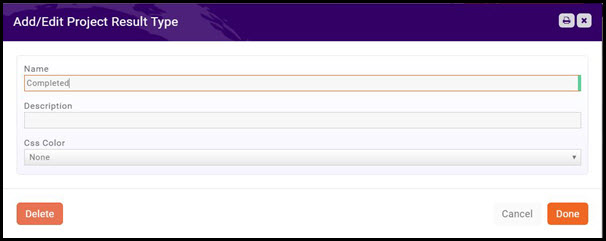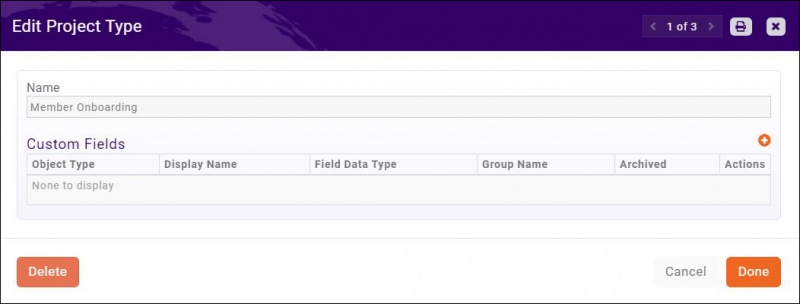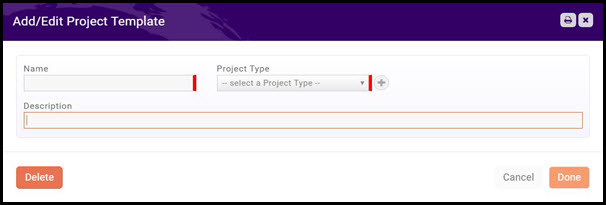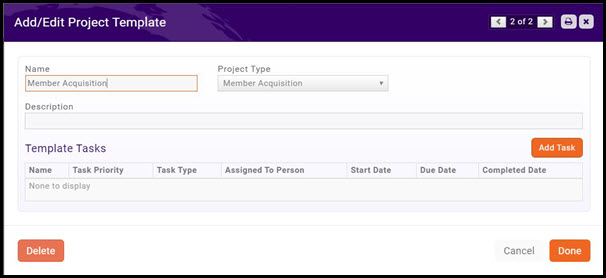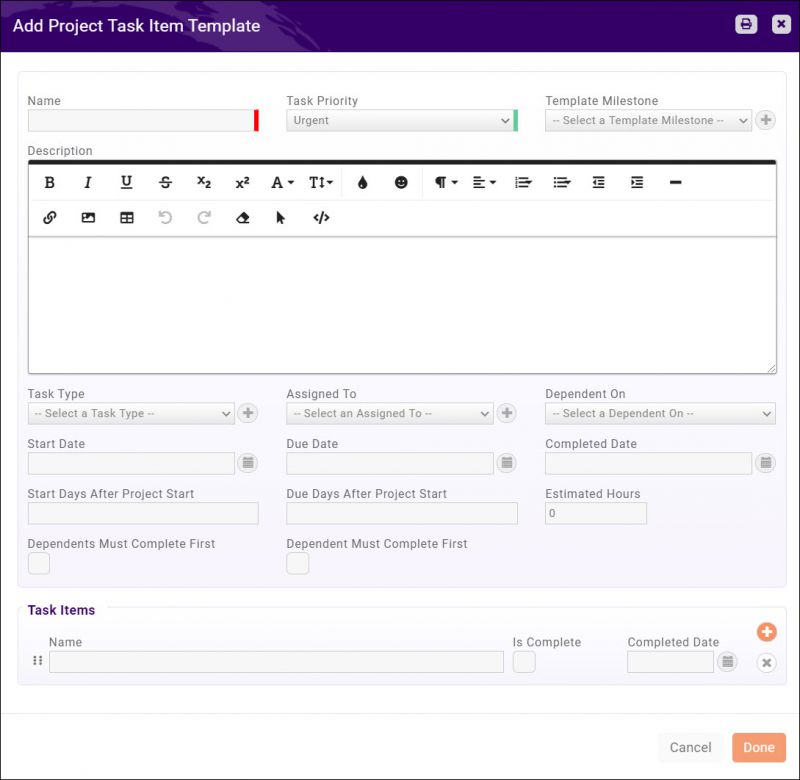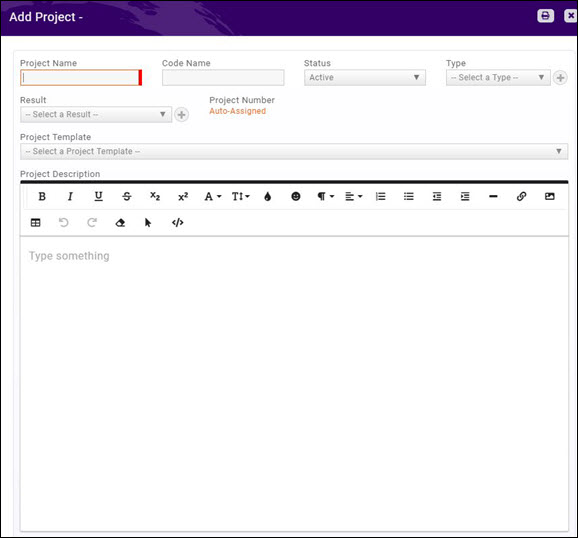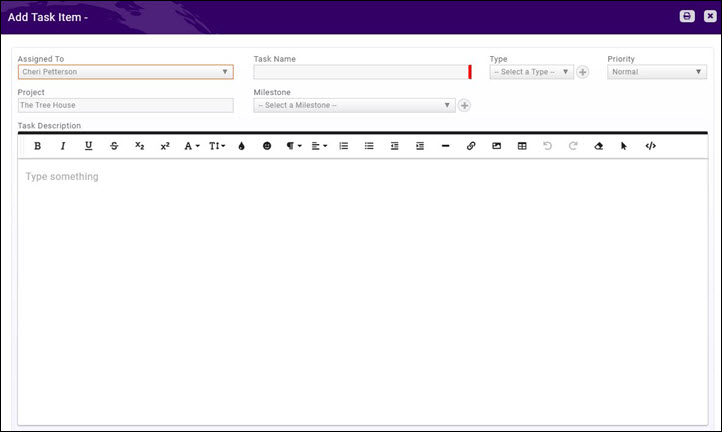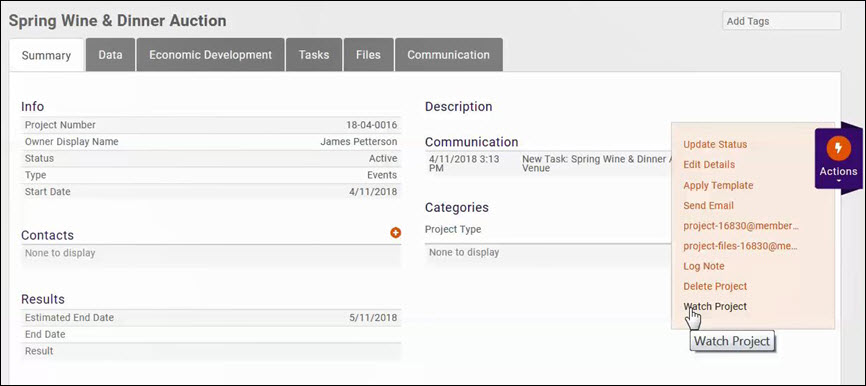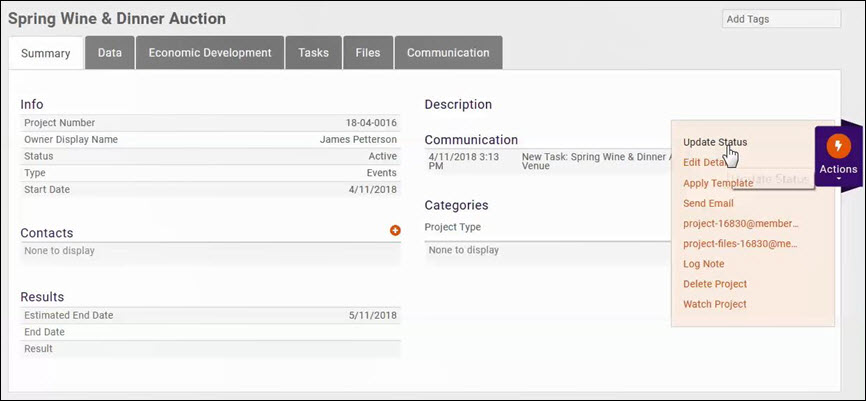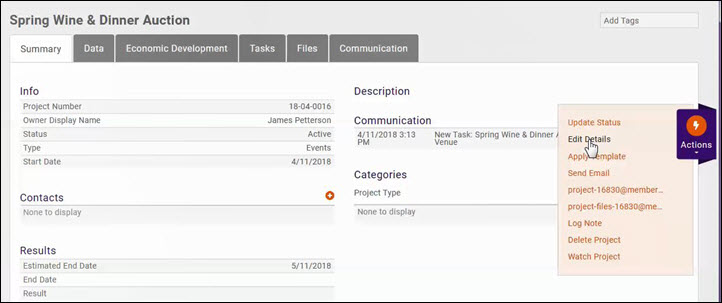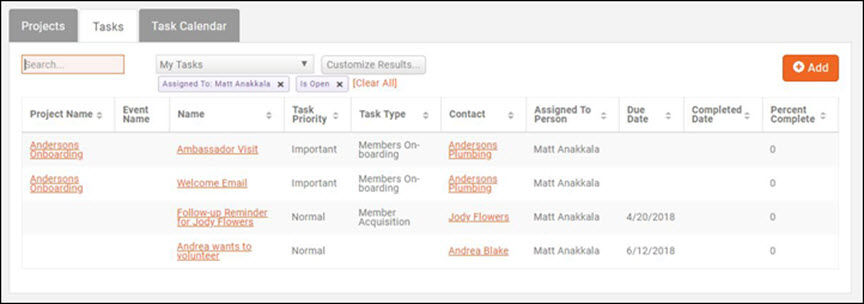Difference between revisions of "Projects"
Cpetterson (talk | contribs) |
|||
| (23 intermediate revisions by 4 users not shown) | |||
| Line 1: | Line 1: | ||
| + | <p style="font-size:30px">NEW!! Find all of your answers in the [https://helpdesk.growthzone.com/kb/article/1831-contents-projects-tasks// GrowthZone Knowledge Base!]</p> | ||
| + | |||
The Project Management module will help you to organize and manage projects from beginning to end. The module can be used to manage your member acquisition, member on-boarding, events, and more. If you have projects that are repeatable (such as member on-boarding) you can create a project template to be re-used, saving you time. Additionally, the project management module allows you to create and monitor individual tasks that you may need outside of an actual project. | The Project Management module will help you to organize and manage projects from beginning to end. The module can be used to manage your member acquisition, member on-boarding, events, and more. If you have projects that are repeatable (such as member on-boarding) you can create a project template to be re-used, saving you time. Additionally, the project management module allows you to create and monitor individual tasks that you may need outside of an actual project. | ||
| − | =Initial Project Management Setup= | + | ='''<span style="color:#800080">Initial Project Management Setup</span>'''= |
Initial setup of your Project Management module allows you to setup default task types, project types, project result types, and project templates. This initial setup will save you time when you are creating projects and/or adding tasks. You will also have the ability to create these items dynamically within the Project Management Module. | Initial setup of your Project Management module allows you to setup default task types, project types, project result types, and project templates. This initial setup will save you time when you are creating projects and/or adding tasks. You will also have the ability to create these items dynamically within the Project Management Module. | ||
| − | ==Task Types== | + | =='''<span style="color:#800080">Task Types</span>'''== |
'''Task Types''' allow you to identify common tasks that you will use in your projects. The task types are the selectable, and available for filtering and reporting purposes. If you are creating a member onboarding project, and example of a task type might be "Personal Visit". You can create your task types pro-actively through the '''Setup''' options, or you may create them dynamically when creating a new project or task. | '''Task Types''' allow you to identify common tasks that you will use in your projects. The task types are the selectable, and available for filtering and reporting purposes. If you are creating a member onboarding project, and example of a task type might be "Personal Visit". You can create your task types pro-actively through the '''Setup''' options, or you may create them dynamically when creating a new project or task. | ||
| Line 20: | Line 22: | ||
#Click '''Done'''. | #Click '''Done'''. | ||
| − | ==Setup Project Result Types== | + | =='''<span style="color:#800080">Setup Project Result Types</span>'''== |
Project Management Result Types allow you to identify expected outcomes for your projects. Examples of result type include: Completed, Cancelled, Acquired, and so on. | Project Management Result Types allow you to identify expected outcomes for your projects. Examples of result type include: Completed, Cancelled, Acquired, and so on. | ||
| Line 34: | Line 36: | ||
#Click '''Done'''. | #Click '''Done'''. | ||
| − | ==Setup Project Types== | + | ==='''<span style="color:#800080">Setup Project Types'''</span>=== |
| + | ---- | ||
Project types allow you to group together projects with similar characteristics. Examples of project types include: Event, Membership, Store Merchandising, and so on. You can create Project Types initially, or you can create types dynamically when you are creating projects. | Project types allow you to group together projects with similar characteristics. Examples of project types include: Event, Membership, Store Merchandising, and so on. You can create Project Types initially, or you can create types dynamically when you are creating projects. | ||
| Line 41: | Line 44: | ||
#Click '''Project Project Types''' in the Projects section. A list of the '''Project Types''' currently configured in your system will be displayed. | #Click '''Project Project Types''' in the Projects section. A list of the '''Project Types''' currently configured in your system will be displayed. | ||
#Click the '''Add''' button. | #Click the '''Add''' button. | ||
| − | #: | + | #:[[File:Edit Project Type.jpg|800px|center]] |
| − | [[File: | ||
#Enter a '''Name''' for the new project type. | #Enter a '''Name''' for the new project type. | ||
| + | #(Optional) If you would like to associate specific custom fields to this Project Type, click the orange plus icon. See '''[[Getting_Started#Custom_Fields|Custom Fields]]''' for further details on creating these fields. The custom fields will display on a project's '''Data''' tab. | ||
#Click '''Done'''. | #Click '''Done'''. | ||
| − | ==Setup Project Templates== | + | =='''<span style="color:#800080">Setup Project Templates</span>'''== |
Project templates can be created for projects that are repeatable, such as New Member On-boarding, Member Acquisition, Events, etc. You can then use these templates and customize them as needed when you create new projects. Creating a template is a two step process (1) Create the template (2) Add tasks to the template. Adding tasks to a template is optional, however, if your project will contain standard repeatable tasks, you can save time by entering them into the template. | Project templates can be created for projects that are repeatable, such as New Member On-boarding, Member Acquisition, Events, etc. You can then use these templates and customize them as needed when you create new projects. Creating a template is a two step process (1) Create the template (2) Add tasks to the template. Adding tasks to a template is optional, however, if your project will contain standard repeatable tasks, you can save time by entering them into the template. | ||
| − | '''Create Template''' | + | ==='''<span style="color:#800080">Create Template</span>'''=== |
#Click '''Setup''' in the Navigation Panel. | #Click '''Setup''' in the Navigation Panel. | ||
| Line 57: | Line 60: | ||
#:[[File:Add Project Template.jpg|frame|center]] | #:[[File:Add Project Template.jpg|frame|center]] | ||
#Enter a '''Name''' for the new template. | #Enter a '''Name''' for the new template. | ||
| − | #Select a '''Project Type'''. You can select from the list, or you can click the ''' | + | #Select a '''Project Type'''. You can select from the list, or you can click the [[File:Plus icon.jpg]] icon to add a new project type. See '''[[Projects#Setup_Project_Types|Setup Project Types]]''' for further information. |
#Enter a '''Description''' of the template. | #Enter a '''Description''' of the template. | ||
#Click '''Done'''. | #Click '''Done'''. | ||
| − | '''Add Tasks to Template''' | + | ==='''<span style="color:#800080">Add Tasks to Template</span>'''=== |
| − | Adding tasks to a template is optional, however, if completing the project entails performing repeatable tasks, you can save time by entering them into the template. | + | Adding tasks to a template is optional, however, if completing the project entails performing repeatable tasks, you can save time by entering them into the template. You will have the opportunity to add additional tasks when the template is used in a project. |
#In the list of project templates, click the template to which you wish to add tasks. | #In the list of project templates, click the template to which you wish to add tasks. | ||
#:[[File:Add Tasks.jpg|frame|center]] | #:[[File:Add Tasks.jpg|frame|center]] | ||
#Click the '''Add Task''' button. | #Click the '''Add Task''' button. | ||
| + | #:[[File:AddProjectTaskItem 08112020.jpg|800px|center|A screenshot of the Add Project Task item window]] | ||
| + | #Configure the following: | ||
| + | #:'''Name''': Enter a name for the task. The name of the task is visible within the project, so be descriptive. | ||
| + | #:'''Priority''': Select a priority for the task. Priority indicates the level of importance of the task. Options include: Rainy Day, Low, Normal, Important and Urgent. | ||
| + | #:'''Template Milestone''': Select a previously configured milestone, or click the [[File:Plus icon.jpg]] to configure a new milestone. The milestones should represent a clear sequence of events that incrementally build up until your project is complete. | ||
| + | #:'''Task Type''': Select a previously configured task type, or click the [[File:Plus icon.jpg]] to configure a new task type. See '''[[Projects#Task_Types|Task Types]]''' for further information. | ||
| + | #:'''Assigned To''': You may select a staff member from the drop-down list, or simply leave this field blank. When you use the template for a project, you will have the opportunity to select the staff member to which you wish to assign the task. | ||
| + | #:'''Dependent On''': If this task is dependent on the completion of another task, select that task from the drop-down list. | ||
| + | #:'''Start Date''', '''Due Date''', '''Completed Date''': Leave these fields blank. When the template is used in a project, these dates will require configuration. | ||
| + | #:'''Start Days After Project Start''', '''Due Days After Project Start''': These are relative date fields and con be configured here to automatically set Start Date and Due Date fields depending on when the project is created or due (i.e. the task is due 3 days after the project start date). ''NOTE: for an automatically created project ('''[[Projects#Auto_Create_Projects_for_New_Membership|Auto Create Project for New Memberships]]'''), the start date would be the join date.'' | ||
| + | #:'''Estimated Hours''': Enter the number of hours you think it will take to complete this task. | ||
| + | #:'''Dependents Must Complete First''': Select this check box if all of the tasks that have the selected task as a "dependent on" must be completed first. When working with the task, the staff member will not be able to mark this task as complete if the dependent tasks have not been marked completed. | ||
| + | #:'''Dependent Must Complete First''': Select this check box if the task selected in the Dependent On dropdown must be completed first. When working with the task, the staff member will not be able to mark this task as complete if the dependent task has not been marked complete. * Only select one option for Dependent and Dependents. Selecting both options will not create dependent tasks. | ||
| + | #:'''Task Items''': Task items allow you to break down the task into smaller, more manageable sub-tasks. | ||
| + | #:*Enter a '''Name''' in the text-box. The '''Is Complete''' and '''Completed Date''' should not be filled in. The will be completed when the template is used in a template. | ||
| + | #:*Click the [[File:Orange plus icon.jpg]] to add additional sub-tasks. | ||
| + | #Click '''Done'''. | ||
| + | #To add additional tasks to your template, click the '''Add Task''' button and complete steps 3 - 4 above. | ||
| + | #Once all tasks have been added to your template, click '''Done'''. | ||
| − | =Create a New Project= | + | ='''<span style="color:#800080">Create a New Project</span>'''= |
| − | When creating a project, you may either create a project from scratch, or you may use a template. | + | When creating a project, you may either create a project from scratch, or you may use a template. |
| + | |||
| + | =='''<span style="color:#800080">Create a Project in the Projects/Tasks Module</span>'''== | ||
| + | |||
| + | To create a project from the Projects/Tasks module: | ||
#Click '''Projects/Tasks''' in the left-hand navigation panel. | #Click '''Projects/Tasks''' in the left-hand navigation panel. | ||
| Line 92: | Line 118: | ||
#*'''Event''': If this project is to be tied to an event, enter the name of the event. Once the project is saved, the project will be displayed on the event's tasks tab. | #*'''Event''': If this project is to be tied to an event, enter the name of the event. Once the project is saved, the project will be displayed on the event's tasks tab. | ||
| − | ==Add Tasks to New Project== | + | =='''<span style="color:#800080">Add Tasks to New Project</span>'''== |
If not using a template to create a project, once the project has been created you will add tasks to it. A task may be a single stand alone task to be performed, or it may have sub-tasks within it. | If not using a template to create a project, once the project has been created you will add tasks to it. A task may be a single stand alone task to be performed, or it may have sub-tasks within it. | ||
| Line 120: | Line 146: | ||
#Click '''Done'''. | #Click '''Done'''. | ||
| − | ==Monitoring & Updating Projects= | + | ='''<span style="color:#800080">Auto Create Projects for New Membership</span>'''= |
| + | You are able to have a specific project template automatically applied when a member joins through the membership application OR when a membership is added through the back office. This can save staff time from having to remember to apply a project to each new member. Once your template is set up, you can apply the templates by adding or editing a membership type. See '''[[Membership_Management#Add_a_New_Membership_Type|Add a New Membership Type]]''' for more information. | ||
| + | |||
| + | ='''<span style="color:#800080">Monitoring & Updating Projects'''</span>= | ||
| + | ---- | ||
Project Monitoring refers to the process of keeping track of all project-related metrics including team performance and task duration, identifying potential problems and taking corrective actions necessary to ensure that the project is within scope and meets the specified deadlines. | Project Monitoring refers to the process of keeping track of all project-related metrics including team performance and task duration, identifying potential problems and taking corrective actions necessary to ensure that the project is within scope and meets the specified deadlines. | ||
| − | ===Watch a Project== | + | =='''<span style="color:#800080">Watch a Project'''</span>== |
| + | ---- | ||
Staff may watch a project, and be sent notifications when: | Staff may watch a project, and be sent notifications when: | ||
| Line 137: | Line 168: | ||
#Click '''Watch Project'''. | #Click '''Watch Project'''. | ||
| − | ===Update the Status of a Project== | + | =='''<span style="color:#800080">Update the Status of a Project'''</span>== |
| + | ---- | ||
To update the status, result, and end date of a project: | To update the status, result, and end date of a project: | ||
| Line 152: | Line 184: | ||
#Click '''Done'''. | #Click '''Done'''. | ||
| − | ===Edit Project Details== | + | =='''<span style="color:#800080">Edit Project Details'''</span>== |
| + | ---- | ||
To edit project details, such as the description, type, contacts, etc.: | To edit project details, such as the description, type, contacts, etc.: | ||
| Line 166: | Line 199: | ||
| − | ===Monitoring/Updating Individual Tasks | + | =='''<span style="color:#800080">Monitoring/Updating Individual Tasks</span>'''== |
Once tasks have been assigned, the staff person to whom the task has been assigned will be sent an email notification. The staff person can view and update tasks in all locations that the tasks are displayed. For example, if an event task has been assigned, the tasks will be displayed on the event tasks tab. Alternately, the staff person can navigate to the Projects/Tasks module: | Once tasks have been assigned, the staff person to whom the task has been assigned will be sent an email notification. The staff person can view and update tasks in all locations that the tasks are displayed. For example, if an event task has been assigned, the tasks will be displayed on the event tasks tab. Alternately, the staff person can navigate to the Projects/Tasks module: | ||
| Line 176: | Line 209: | ||
The list of tasks displayed is now filtered to the specific staff member. At a glance, the list displays the name of the task, the priority of the task, the due date, percent complete, etc. | The list of tasks displayed is now filtered to the specific staff member. At a glance, the list displays the name of the task, the priority of the task, the due date, percent complete, etc. | ||
| − | ====Updating Individual Tasks==== | + | Staff will also have an indicator in the upper bar of GrowthZone to show tasks that are due. The Icon will navigate the staff user to their own task list. The icon will display a number for the tasks that are due that day or past due. |
| + | [[File:Task.jpg|frame|left]] | ||
| + | |||
| + | ===='''<span style="color:#800080">Updating Individual Tasks</span>'''==== | ||
By updating individual tasks, you can re-assign the task to another staff member, add notes, mark individual sub-tasks as completed, | By updating individual tasks, you can re-assign the task to another staff member, add notes, mark individual sub-tasks as completed, | ||
| Line 218: | Line 254: | ||
'''NOTE:''' After saving the update, the '''Percent Complete''' in the '''Status''' section will automatically be updated. | '''NOTE:''' After saving the update, the '''Percent Complete''' in the '''Status''' section will automatically be updated. | ||
| + | {| class="wikitable" | ||
| + | |- | ||
| + | | | ||
| + | [[File:Smallest.png|25px]] | ||
| + | | style="width: 100%"| '''NOTE:''' After saving the update, the '''Percent Complete''' in the '''Status''' section will automatically be updated. | ||
| + | |} | ||
| − | == | + | ==='''<span style="color:#800080">Project/Tasks Reports'''</span>=== |
| − | + | ---- | |
| − | + | Several reports are available for managing and analyzing your projects. See '''[[Reports#Project.2FTasks_Reports|Project/Tasks Reports]]'''. | |
| − | |||
| − | |||
| − | |||
| − | |||
| − | |||
| − | |||
| − | # | ||
| − | |||
| − | |||
| − | |||
| − | |||
| − | |||
| − | |||
| − | |||
| − | |||
| − | |||
| − | |||
| − | |||
| − | |||
| − | |||
| − | |||
| − | |||
| − | |||
| − | |||
| − | |||
| − | |||
| − | |||
| − | |||
| − | |||
| − | |||
| − | |||
| − | |||
| − | |||
| − | |||
| − | |||
| − | |||
| − | |||
| − | |||
| − | |||
| − | |||
| − | |||
| − | |||
| − | |||
| − | |||
| − | |||
| − | |||
| − | |||
| − | |||
| − | |||
| − | |||
| − | |||
| − | |||
| − | |||
| − | |||
| − | |||
| − | |||
| − | |||
| − | |||
| − | |||
| − | |||
| − | |||
| − | |||
| − | |||
| − | |||
| − | |||
| − | |||
| − | |||
| − | # | ||
| − | |||
| − | |||
| − | |||
| − | |||
| − | |||
| − | |||
| − | |||
| − | |||
| − | |||
| − | |||
| − | |||
| − | |||
| − | |||
| − | |||
| − | |||
| − | |||
| − | |||
| − | |||
| − | |||
| − | |||
| − | |||
| − | |||
| − | |||
| − | |||
| − | |||
| − | |||
| − | |||
| − | |||
| − | |||
| − | |||
| − | |||
| − | |||
| − | |||
| − | |||
| − | |||
| − | |||
| − | |||
| − | |||
| − | |||
| − | |||
| − | |||
| − | |||
| − | |||
| − | |||
| − | |||
| − | |||
| − | |||
| − | |||
| − | |||
| − | |||
| − | |||
Latest revision as of 12:21, 1 April 2021
NEW!! Find all of your answers in the GrowthZone Knowledge Base!
The Project Management module will help you to organize and manage projects from beginning to end. The module can be used to manage your member acquisition, member on-boarding, events, and more. If you have projects that are repeatable (such as member on-boarding) you can create a project template to be re-used, saving you time. Additionally, the project management module allows you to create and monitor individual tasks that you may need outside of an actual project.
Contents
Initial Project Management Setup
Initial setup of your Project Management module allows you to setup default task types, project types, project result types, and project templates. This initial setup will save you time when you are creating projects and/or adding tasks. You will also have the ability to create these items dynamically within the Project Management Module.
Task Types
Task Types allow you to identify common tasks that you will use in your projects. The task types are the selectable, and available for filtering and reporting purposes. If you are creating a member onboarding project, and example of a task type might be "Personal Visit". You can create your task types pro-actively through the Setup options, or you may create them dynamically when creating a new project or task.
- Click Setup on the Navigation Panel.
- Click Task Types in the Projects section. A list of the task types that are currently configured in your system will be displayed.
- Click the Add button.
- Configure the following:
- Name - Provide a name for the task type. This is the name that will display when you are selecting tasks, and will be used for filtering and reporting purposes.
- Description - Provide a description of the task. This will help you in understanding the purpose of the task.
- Cas Color - N/A
- Click the Is Active check-box to activate this task.
- Click Done.
Setup Project Result Types
Project Management Result Types allow you to identify expected outcomes for your projects. Examples of result type include: Completed, Cancelled, Acquired, and so on.
- Click Setup in the Navigation Panel.
- Click Project Result Types in the Projects section. A list of the Project Result Types currently configured in your system will be displayed.
- Click the Add button.
- Configure the following settings:
- Name - This is the name that will appear for selection when working on tasks and projects. This will also be used for filtering and reporting.
- Description - Provide a description of the result type.
- Cas Color - N/A.
- Click Done.
Setup Project Types
Project types allow you to group together projects with similar characteristics. Examples of project types include: Event, Membership, Store Merchandising, and so on. You can create Project Types initially, or you can create types dynamically when you are creating projects.
- Click Setup in the Navigation Panel.
- Click Project Project Types in the Projects section. A list of the Project Types currently configured in your system will be displayed.
- Click the Add button.
- Enter a Name for the new project type.
- (Optional) If you would like to associate specific custom fields to this Project Type, click the orange plus icon. See Custom Fields for further details on creating these fields. The custom fields will display on a project's Data tab.
- Click Done.
Setup Project Templates
Project templates can be created for projects that are repeatable, such as New Member On-boarding, Member Acquisition, Events, etc. You can then use these templates and customize them as needed when you create new projects. Creating a template is a two step process (1) Create the template (2) Add tasks to the template. Adding tasks to a template is optional, however, if your project will contain standard repeatable tasks, you can save time by entering them into the template.
Create Template
- Click Setup in the Navigation Panel.
- Click Project Templates in the Projects section. A list of the Project Templates currently configured in your system will be displayed.
- Click the Add button.
- Enter a Name for the new template.
- Select a Project Type. You can select from the list, or you can click the
 icon to add a new project type. See Setup Project Types for further information.
icon to add a new project type. See Setup Project Types for further information. - Enter a Description of the template.
- Click Done.
Add Tasks to Template
Adding tasks to a template is optional, however, if completing the project entails performing repeatable tasks, you can save time by entering them into the template. You will have the opportunity to add additional tasks when the template is used in a project.
- In the list of project templates, click the template to which you wish to add tasks.
- Click the Add Task button.
- Configure the following:
- Name: Enter a name for the task. The name of the task is visible within the project, so be descriptive.
- Priority: Select a priority for the task. Priority indicates the level of importance of the task. Options include: Rainy Day, Low, Normal, Important and Urgent.
- Template Milestone: Select a previously configured milestone, or click the
 to configure a new milestone. The milestones should represent a clear sequence of events that incrementally build up until your project is complete.
to configure a new milestone. The milestones should represent a clear sequence of events that incrementally build up until your project is complete. - Task Type: Select a previously configured task type, or click the
 to configure a new task type. See Task Types for further information.
to configure a new task type. See Task Types for further information. - Assigned To: You may select a staff member from the drop-down list, or simply leave this field blank. When you use the template for a project, you will have the opportunity to select the staff member to which you wish to assign the task.
- Dependent On: If this task is dependent on the completion of another task, select that task from the drop-down list.
- Start Date, Due Date, Completed Date: Leave these fields blank. When the template is used in a project, these dates will require configuration.
- Start Days After Project Start, Due Days After Project Start: These are relative date fields and con be configured here to automatically set Start Date and Due Date fields depending on when the project is created or due (i.e. the task is due 3 days after the project start date). NOTE: for an automatically created project (Auto Create Project for New Memberships), the start date would be the join date.
- Estimated Hours: Enter the number of hours you think it will take to complete this task.
- Dependents Must Complete First: Select this check box if all of the tasks that have the selected task as a "dependent on" must be completed first. When working with the task, the staff member will not be able to mark this task as complete if the dependent tasks have not been marked completed.
- Dependent Must Complete First: Select this check box if the task selected in the Dependent On dropdown must be completed first. When working with the task, the staff member will not be able to mark this task as complete if the dependent task has not been marked complete. * Only select one option for Dependent and Dependents. Selecting both options will not create dependent tasks.
- Task Items: Task items allow you to break down the task into smaller, more manageable sub-tasks.
- Click Done.
- To add additional tasks to your template, click the Add Task button and complete steps 3 - 4 above.
- Once all tasks have been added to your template, click Done.
Create a New Project
When creating a project, you may either create a project from scratch, or you may use a template.
Create a Project in the Projects/Tasks Module
To create a project from the Projects/Tasks module:
- Click Projects/Tasks in the left-hand navigation panel.
- Click on the Projects tab, click the Add button.
- Configure the following:
- Project Name: Enter a name for the project. Best practice is to provide a name that provides a good understanding of the project.
- Code Name:
- Status: Select Active from the drop-down. Changes to the status of the project may be updated through the lifetime of the project.
- Result: Select the desired result from the drop-down list. This field may be updated through-out the life of the project. For Example, if this is a project for membership acquisition, a result might be "Acquired". If the prospect is not acquired, you may return to the project to change the result.
- Project Template: If you wish to use an existing project template, select it from the drop-down.
- Project Description: Enter a description of the project. This is a good location to document your project scope, etc.
- Custom Fields: If there is additional information you wish to track about this project, click the + sign to add custom fields.
- Start Date: Enter the start date of the project. The system will default to the current date.
- Estimated End Date: Enter the estimated end date of the project.
- End Date: When creating the project, this field should be left blank. You can fill this in once the project has been completed.
- Owner: Select the owner of the project from the drop-down list.
- Project Contacts: If this project is to be tied to a contact in your database, enter the name of the contact. Once the project is save, you will see the project on the contact's profile tab. NOTE: Alternately, the project could have been created directly from the contact's profile tab.
- Categories: Select a category from the drop-down list. Categories make it easy for you to search, filter and report on projects.
- Event: If this project is to be tied to an event, enter the name of the event. Once the project is saved, the project will be displayed on the event's tasks tab.
Add Tasks to New Project
If not using a template to create a project, once the project has been created you will add tasks to it. A task may be a single stand alone task to be performed, or it may have sub-tasks within it.
- Click Projects/Tasks in the left-hand navigation panel.
- Click the desired project from the projects list.
- Once the project is open, click the Tasks tab. A list of all tasks associated to the project will be displayed.
- Click the Add button.
- Configure the following:
- Assigned To: Select the person you wish to assign this task to. Once the task is saved, the person the task has been assigned to will receive the Task Assigned automated email notification.
- Task Type: Select a task type from the list. Task types are a way by which you will be able to report, search and filter tasks. If you wish to add a new task, click the
 icon. For further information on creating task types, see Task Types.
icon. For further information on creating task types, see Task Types. - Priority: Select the desired priority for this task.
- Project: The name of your project will be displayed.
- Milestone: Select the desired milestone from the drop-down. By using milestones, you can divide the project into specific phases. If you wish to add a new milestone, click the
 icon.
icon. - Task Description: Provide a description of the task.
- Tasks Items: If the task includes sub items, click the
 to add.
to add.
- Enter a name for the sub-task. The completed check-box, and completed date should be left blank when you first are creating the task.
- To add additional tasks, click the
 .
. - Status:
- Start Date: Enter the desired start date for this task.
- Due Date: Select the desired due date for this task.
- Estimate Hours: Enter the number of hours that you estimate this task will take to complete.
- Dependent On: If other tasks must be completed in order to complete this task, select the dependent task(s) from the drop-down list. You will not be allowed to mark this task as completely until the dependent tasks have been completed.
- Completed On: This is the date that the dependent task is completed. If this task has been completed, the completed date will be automatically populated.
- Click Done.
Auto Create Projects for New Membership
You are able to have a specific project template automatically applied when a member joins through the membership application OR when a membership is added through the back office. This can save staff time from having to remember to apply a project to each new member. Once your template is set up, you can apply the templates by adding or editing a membership type. See Add a New Membership Type for more information.
Monitoring & Updating Projects
Project Monitoring refers to the process of keeping track of all project-related metrics including team performance and task duration, identifying potential problems and taking corrective actions necessary to ensure that the project is within scope and meets the specified deadlines.
Watch a Project
Staff may watch a project, and be sent notifications when:
- A project they are watching is completed
- When a task is completed for a project they are watching
- Click Projects/Tasks in the left-hand navigation panel.
- On the Projects tab, select the project you wish to update.
- Click the common tasks Action button.
- Click Watch Project.
Update the Status of a Project
To update the status, result, and end date of a project:
- Click Projects/Tasks in the left-hand navigation panel.
- On the Projects tab, select the project you wish to update.
- Click the common tasks Action button.
- Click Update Status.
- Update Status as needed.
- Update Result as needed.
- Update End Date as needed.
- Click Done.
Edit Project Details
To edit project details, such as the description, type, contacts, etc.:
- Click Projects/Tasks in the left-hand navigation panel.
- On the Projects tab, select the project you wish to update.
- Click the common tasks Action button.
- Click Edit Details.
- Edit the desired fields.
- Click Done.
Monitoring/Updating Individual Tasks
Once tasks have been assigned, the staff person to whom the task has been assigned will be sent an email notification. The staff person can view and update tasks in all locations that the tasks are displayed. For example, if an event task has been assigned, the tasks will be displayed on the event tasks tab. Alternately, the staff person can navigate to the Projects/Tasks module:
- Click Projects/Tasks in the left-hand navigation panel.
- Click the Tasks tab.
- Filter in the Show Only drop-down list to My Tasks.
The list of tasks displayed is now filtered to the specific staff member. At a glance, the list displays the name of the task, the priority of the task, the due date, percent complete, etc.
Staff will also have an indicator in the upper bar of GrowthZone to show tasks that are due. The Icon will navigate the staff user to their own task list. The icon will display a number for the tasks that are due that day or past due.
Updating Individual Tasks
By updating individual tasks, you can re-assign the task to another staff member, add notes, mark individual sub-tasks as completed,
- Click Projects/Tasks in the left-hand navigation panel.
- Click the Tasks tab.
- Filter in the Show Only drop-down list to My Tasks.
- The list of tasks displayed is now filtered to the specific staff member. At a glance, the list displays the name of the task, the priority of the task, the due date, percent complete, etc.
- Click the link for the task you wish to update.
Re-assign a Task
To re-assign a task, open the task as described above:
- In the Assigned to drop-down list, select the the staff member to whom this task is to be re-assigned.
- Click Done.
An automated email will be sent to the staff member assigned.
Update Task Completion Progress
To update the completion progress of a task:
NOTE: Follow this procedure if there are no sub-tasks associated with the task. If sub-tasks are associated to the task, see ??? for updating completion progress of sub-tasks.
- Open the task, as described above.
- Scroll to the Status section.
- If the task is partially completed, enter the percent completed, or click the check-box to mark the task as completed. The Completed Date will be automatically populated with the current date.
Update Status of Sub-tasks
To update the completion status of Sub-tasks:
- Open the task, as described above.
- Scroll to the Task Items section.
- Click the checkbox for the items that have been completed. The Completed Date will automatically be populated with the current date.
- Click Done.
NOTE: After saving the update, the Percent Complete in the Status section will automatically be updated.
| NOTE: After saving the update, the Percent Complete in the Status section will automatically be updated. |
Project/Tasks Reports
Several reports are available for managing and analyzing your projects. See Project/Tasks Reports.

